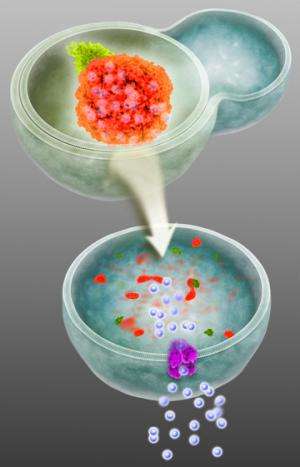Scientists discover key player in molecular machinery controlling iron availability

(Medical Xpress)—Iron is critical for cellular health. Too little means the cell can't make essential proteins that require iron for their functions, but too much can be toxic.
Scientists have been studying how cells achieve iron homeostasis—the happy medium between too little and too much of this valuable metal. Now research from Harvard Medical School, Dana-Farber Cancer Institute and Beth Israel Deaconess Medical Center has revealed the role of autophagy in this iron-balancing act, a process that is also known to be critical in cancer and neurodegeneration. This research team discovered a protein that ensures delivery of iron cargo to the cellular recycling factory.
These findings are published March 30 in Nature.
The lysosome is a recycling organelle within the cell that degrades material when the cell's needs change. When iron levels are too high, a major iron buffer called ferritin forms a proteinaceous cage around iron molecules, protecting the cell from unwanted oxidative damage promoted by free iron. But when iron levels are too low, the ferritin cage travels to the lysosome, which in turn breaks down the cage and releases iron to the cell.
Delivering iron to the lysosome happens through a process called autophagy, which means "self-eating." Molecules within the cell are swallowed up by double-membrane structures called autophagosomes and ferried to the lysosome. Sometimes the cargo is damaged and destined for destruction; other times the cargo is selected more specifically to suit the cell's needs (referred to as "selective autophagy").
A growing body of evidence implicates the autophagy process in diseases such as cancer and neurodegeneration. The high levels of autophagy required to support pancreatic cancer growth caught the attention of Joseph Mancias, HMS instructor in radiation oncology at Beth Israel Deaconess Medical Center and lead author of the paper, who was interested in whether this dependence on autophagy was due to the degradation of specific cargo.
Using quantitative proteomics—tools that identify and characterize proteins—Mancias identified a group of proteins that reside in autophagosomes. One of the most robust hits was a protein called NCOA4, short for nuclear receptor co-activator 4. Through more proteomic analysis they found NCOA4 in the autophagosomes of multiple cell lines—not just cancer cells—where it was always bound to ferritin.
These and several experiments adding or removing NCOA4 from cells convinced the researchers that the protein was acting as an autophagy receptor for ferritin in all the cell types they examined. They showed that NCOA4 was required for ferritin to deliver iron to the lysosome.
"There are very few examples where single proteins are selectively delivered to the autophagosome," said Wade Harper, the Bert and Natalie Vallee Professor of Molecular Pathology in the HMS Department of Cell Biology and a co-senior author of the paper. "Ferritin is a critical protein that forms a cage structure, which is utilized for iron storage. While it was known for many years that ferritin was degraded in the lysosome, the molecular mechanisms had not been identified."
When ferritin is degraded in the lysosome, iron is pumped out and subsequently loaded into iron-dependent proteins via a series of iron-assembly complexes.
Although cancer cells were their starting point, the scientists identified a more general cellular mechanism, which appears to function broadly.
"We ended up with an understanding of how ferritin gets to the autophagosomes and the lysosome and how it plays into the larger network of iron-regulatory proteins," said Mancias, who is a member of the Harper Laboratory and the Kimmelman Laboratory. Alec Kimmelman, HMS assistant professor of radiation oncology at Dana-Farber, is co-senior author of the paper.
An imbalance in iron levels has been linked to numerous diseases, including various forms of neurodegeneration, and rare mutations exist in ferritin that affect either iron capture or ferritin trafficking in the axons of nerve cells. Mancias noted that further studies are needed to understand the extent to which trafficking of ferritin through the autophagosome-lysosome pathway is defective in disease.
Before exploring these and other questions, the scientists' next step is to test in animals what they have found in cell culture to get a fuller, physiological picture of the iron story. "There are many different angles where trafficking of iron could be important," Mancias said.
"Iron is so fundamental that its regulation has to be tightly controlled," said Kimmelman, HMS assistant professor of radiation oncology at Dana-Farber and co-senior author of the paper. "Given how important iron is to human physiology, it makes sense that we have evolved mechanisms that allow for the coordinated delivery of ferritin to the lysosome for degradation. While the identification of an autophagy receptor for ferritin is of great interest, future studies will be needed to elucidate the precise roles of this pathway in normal physiologic as well as pathologic states."
More information: "Quantitative proteomics identifies NCOA4 as the cargo receptor mediating ferritinophagy." Joseph D. Mancias. Nature (2014) DOI: 10.1038/nature13148. Received 09 September 2013 Accepted 12 February 2014 Published online 30 March 2014

















